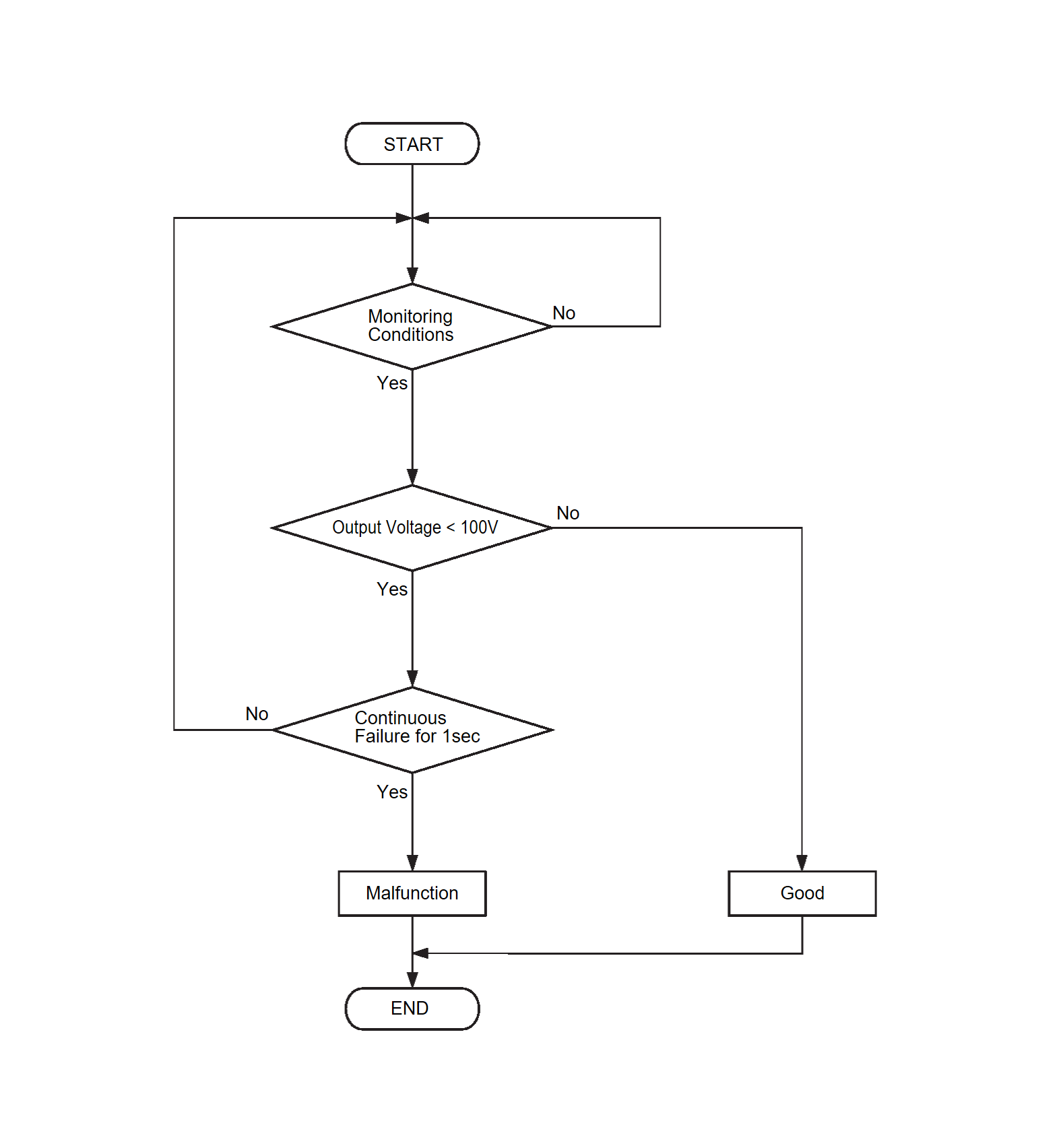DTC No. P1C6E-16: OBC DC Output under voltage
| danger |
|
MONITOR EXECUTION
Continuous
MONITOR EXECUTION CONDITIONS (Other monitor and Sensor)
Other Monitor (There is no temporary DTC set in memory for the item monitored below)
- On Board Charger (OBC) monitor
Sensor (The sensor below is determined to be normal)
- Output voltage sensor
Check Condition
- Any of the following conditions is satisfied.
- The vehicle status is in Propulsion system active for 1 second or more.
- Charge permission from PHEV-ECU: ON
Judgment Criterion
- The output voltage is less than 100 volts for 1 second or more.
OBD-II DRIVE CYCLE PATTERN
- Refer to OBD-II Drive Cycle OBD-II DRIVE CYCLE
 .
.
TROUBLESHOOTING HINTS
- Malfunction of the high-voltage circuit
- Malfunction of the junction box
- Malfunction of the high-voltage fuse (30 A) for On Board Charger (OBC)/DC-DC converter
- Malfunction of the On Board Charger (OBC)/DC-DC converter
DIAGNOSIS
Required Special Tools:
- MB992744: Vehicle communication interface-Lite (V.C.I.-Lite)
- MB992745: V.C.I.-Lite main harness A
- MB992747: V.C.I.-Lite USB cable short
- MB992748: V.C.I.-Lite USB cable long
- MB991223: Wiring harness set
- MB992006: Extra fine probe
1.M.U.T.-IIISE other system DTC
Check whether the REMCU sets the following DTC. Troubleshoot the set DTCs (Refer to DIAGNOSTIC TROUBLE CODE CHART
Troubleshoot the set DTCs (Refer to DIAGNOSTIC TROUBLE CODE CHART ) . Then,
) . Then, 
- Code No. P30D1-16 Rear drive motor voltage-low
- Code No. P0C7A-00 Rear drive motor voltage-high
Is the DTC set?
 Troubleshoot the set DTCs (Refer to DIAGNOSTIC TROUBLE CODE CHART
Troubleshoot the set DTCs (Refer to DIAGNOSTIC TROUBLE CODE CHART ) . Then,
) . Then, 
2.Check of the high-voltage fuse (30 A) for On Board Charger (OBC)/DC-DC converter
| danger |
|
Check the high voltage fuse (30 A) for On Board Charger (OBC)/DC-DC converter (Refer to CHECK AND REPLACEMENT OF HIGH-VOLTAGE FUSE INSIDE THE JUNCTION BOX ).
).
 ).
).Is the check result normal?
3.Visually check of the inside of the junction box
| danger |
|
Visually check that there is no burnout, damage, foreign material inside the junction box.
Is the check result normal?
 Replace the junction box (Refer to JUNCTION BOX REMOVAL AND INSTALLATION
Replace the junction box (Refer to JUNCTION BOX REMOVAL AND INSTALLATION ). Then,
). Then, 
4.Check the installation of the P, N terminals on On Board Charger (OBC)/DC-DC converter.
| danger |
|
Check that the P, N terminals of the On Board Charger (OBC)/DC-DC converter is installed to the junction box with specified torque.
Is the check result normal?
5.Check of continuity at the high-voltage circuit inside the junction box.
| danger |
|
Check the continuity of the high-voltage circuit inside the junction box (Refer to CONTINUITY CHECK FOR HIGH VOLTAGE CIRCUIT IN JUNCTION BOX ).
).
 ).
).Is the check result normal?
6.Test the OBD-II drive cycle.
(1) Carry out a test drive with the drive cycle pattern. Refer to OBD-II Drive Cycle OBD-II DRIVE CYCLE .
.
 .
.(2) Check the DTC.
Is the DTC set?
 Replace the On Board Charger (OBC)/DC-DC converter (Refer to ON BOARD CHARGER (OBC) &DC-DC CONVERTER REMOVAL AND INSTALLATION
Replace the On Board Charger (OBC)/DC-DC converter (Refer to ON BOARD CHARGER (OBC) &DC-DC CONVERTER REMOVAL AND INSTALLATION ). Then,
). Then, 
 The trouble can be an intermittent malfunction (Refer to General Information - How to Use Troubleshooting/Inspection Service Points, How to Cope with Intermittent Malfunctions HOW TO COPE WITH INTERMITTENT MALFUNCTIONS
The trouble can be an intermittent malfunction (Refer to General Information - How to Use Troubleshooting/Inspection Service Points, How to Cope with Intermittent Malfunctions HOW TO COPE WITH INTERMITTENT MALFUNCTIONS ).
).7.Test the OBD-II drive cycle.
(1) Carry out a test drive with the drive cycle pattern. Refer to OBD-II Drive Cycle OBD-II DRIVE CYCLE .
.
 .
.(2) Check the DTC.
Is the DTC set?
 Retry the troubleshooting.
Retry the troubleshooting. The procedure is complete.
The procedure is complete.![[Previous]](../../../buttons/fprev.png)
![[Next]](../../../buttons/fnext.png)
